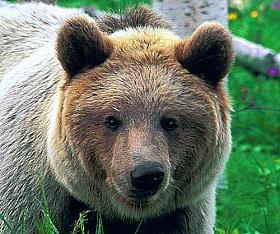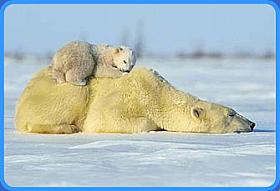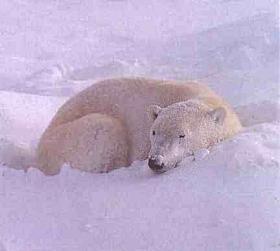
Brown Bears (Grizzlies)
As winter approaches, brown bears—often called grizzly bears—prepare for a long hibernation. During the fall, a brown bear eats practically around the clock, stocking up for the four to seven months when it’ll have to live off stored body fat. A grizzly may chow down on 90 pounds (40 kilograms) of food each day.
As the cold swoops in, the fattened bear waddles into a den among rocks or one it dug out among tree roots. As it falls into a deep sleep, the bear’s heart rate drops from about 40 beats a minute to as low as 8 beats a minute. All the bear’s body functions slow down.
FUN FACTS
In North America, most brown bears live in the western provinces of Canada and in Alaska. Smaller populations live in Wyoming, Montana, Idaho, and Washington.
Brown bears are found in northern North America, Europe, and Asia, in isolated areas that are undeveloped by humans.
The female brown bear enters her den pregnant with one (sometimes two or three) baby bears. If she succeeded in finding enough food to have a healthy store of fat, the embryo, or tiny developing baby bear, continues to develop and is born after a couple of months. If the mother didn’t fatten up enough, the embryo might not develop.
“Mama bear” doesn’t even wake up as her blind and hairless cub is born midwinter. The tiny bear, about the size of a chipmunk, is just strong enough to crawl into a position where it settles in to nurse. A female brown bear’s milk is very rich in fat and calories, so the cub grows quickly. By the time the adult grizzly wakes up in the spring, her baby is strong enough to follow her out of the den.
Nearly half of all brown bear cubs born are likely to die before they’re a year old. Some die of disease, and others die of starvation. Predators such as wolves, mountain lions, and adult male bears—even a cub’s own father—are threats, especially to cubs that are separated from their mothers. But mother brown bears are fiercely protective, so many cubs do survive. They live with their mothers for up to three years, and then they’re usually ready to face life on their own.

Polar Bears
Scientists believe that Ursus maritimus, the "sea bear," evolved about 200,000 years ago from brown bear ancestors.
Polar bears are superbly adapted for survival in the Far North.
Polar bears are the world's largest land predators. They top the food chain in the Arctic, where they dine
primarily on seals.
Adult male polar bears weigh from 775 to more than 1,500 pounds. Females are considerably smaller, normally weighing 330 to 550 pounds.
Polar bears range throughout the Arctic in areas where they can hunt seals at open leads. The five "polar bear nations" where the ice bears are found include the U. S. (Alaska), Canada, Russia, Denmark (Greenland), and Norway.
Adaption to Cold
 Polar bears are well-adapted to severe cold. Winter temperatures in the far north often plunge to -40° F or -50° F and can stay that way for days or even weeks.
Polar bears are well-adapted to severe cold. Winter temperatures in the far north often plunge to -40° F or -50° F and can stay that way for days or even weeks.
In January and February, the average temperature in the high Arctic is -29° F.
The Arctic stays black and fiercely cold for months on end. In the High Arctic, the sun sets in October and does not rise again until late February.
The word "Arctic" comes from the ancient Greek Arktikos, or "country of the great bear." Though the Greeks had no knowledge of the polar bear, they named the region after the constellation Ursus Major, the Great Bear, found in the Northern Sky.
A thick layer of blubber (up to 4.5 inches thick) provides polar bears with such excellent insulation that their body temperature and metabolic rate remain the same even at -34°F.
A polar bear's body temperature is 98.6°, which is average for mammals.
On bitterly cold days with fierce winds, polar bears dig out a shelter in a snow bank and curl up in a tight ball to wait out the storm.
When curled up in a ball, polar bears sometimes cover their muzzles — which radiate heat — with one of their thickly furred paws.
Polar bears know how to pack on the fat: A single bear can consume 100 pounds of blubber at one sitting.
The polar bear's compact ears and small tail also help prevent heat loss.
Polar bears have two layers of fur for further protection from the cold.
Polar bears have more problems with overheating than they do with cold. Even in very cold weather, they quickly overheat when they try to run.
Polar bears generally walk at a leisurely pace to keep from overheating. When a Norwegian scientist, Nils Oritsland, studied a polar bear on a treadmill, he found that his subject would move off for short periods of time at higher speeds and would sometimes lie down and refuse to walk at all!
Let us know your views
Send us your photos, information sheets, fun facts, and views on endangered animals or any wildlife or pets. If, like us, you love animals, we'd love to hear from you... You can contact our staff via e-mail on enquiries@animal-web.com.


 To book this space for your advertisement - contact us at enquiries@animal-web.com.
To book this space for your advertisement - contact us at enquiries@animal-web.com.


 Polar bears are well-adapted to severe cold. Winter temperatures in the far north often plunge to -40° F or -50° F and can stay that way for days or even weeks.
Polar bears are well-adapted to severe cold. Winter temperatures in the far north often plunge to -40° F or -50° F and can stay that way for days or even weeks.